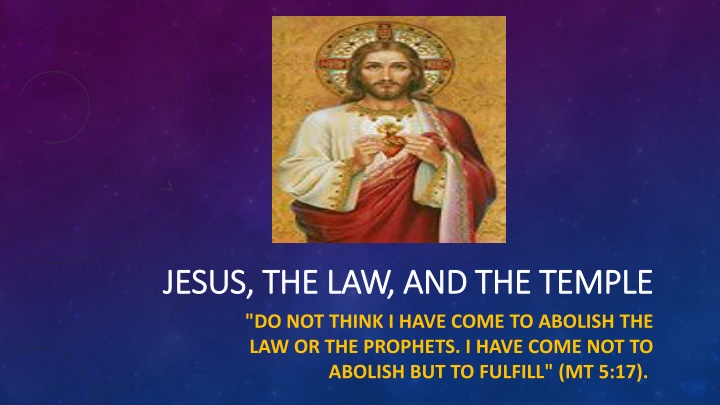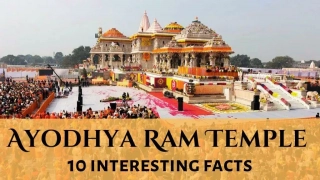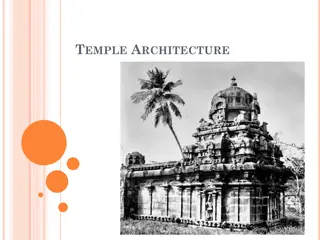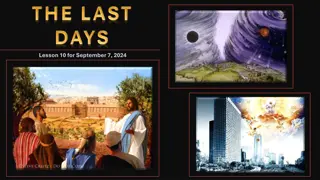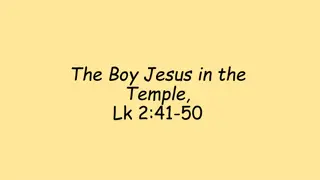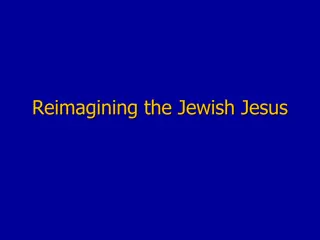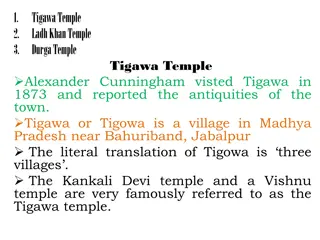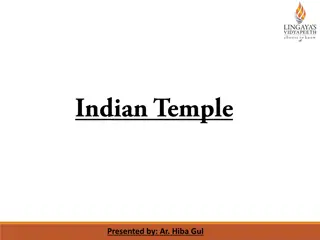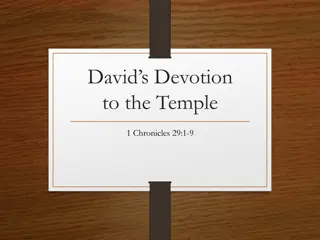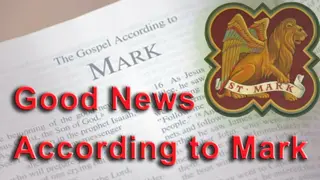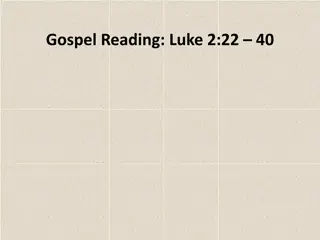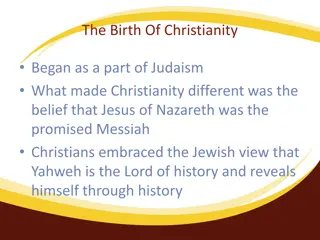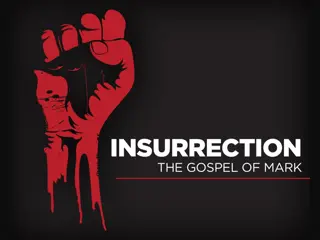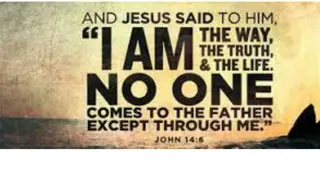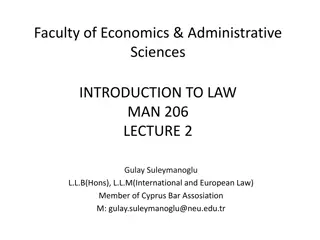JESUS, THE LAW, AND THE TEMPLE
Keeping the law, respecting the Temple, and predicting its destruction, Jesus challenged religious authorities with his teachings on forgiveness. His actions and words reflected a deep connection to the divine law and a new understanding of spiritual principles.
Download Presentation

Please find below an Image/Link to download the presentation.
The content on the website is provided AS IS for your information and personal use only. It may not be sold, licensed, or shared on other websites without obtaining consent from the author.If you encounter any issues during the download, it is possible that the publisher has removed the file from their server.
You are allowed to download the files provided on this website for personal or commercial use, subject to the condition that they are used lawfully. All files are the property of their respective owners.
The content on the website is provided AS IS for your information and personal use only. It may not be sold, licensed, or shared on other websites without obtaining consent from the author.
E N D
Presentation Transcript
JESUS, THE LAW, AND THE TEMPLE JESUS, THE LAW, AND THE TEMPLE "DO NOT THINK I HAVE COME TO ABOLISH THE LAW OR THE PROPHETS. I HAVE COME NOT TO ABOLISH BUT TO FULFILL" (MT 5:17).
KEEPING THE LAW KEEPING THE LAW As Israel's Messiah, Jesus kept the law in its all-embracing detail, to "the least of these commandments. The Jews admitted that they could not observe the Law and had an annual Day of Atonement. The Pharisees had a zeal for the Law but unfortunately they lapsed into a hypocritical casuistry. Otherwise, they could have prepared for God's intervention in Jesus. Only Jesus, the Divine Legislator, "born of a woman, born under the law," could perfectly fulfill this law. Jesus had the Law engraved on his heart. He took upon himself "the curse of the Law" so he could redeem men "from the transgressions under the first Covenant.
OFFENDING SOME TEACHERS OFFENDING SOME TEACHERS RESPECT FOR THE TEMPLE RESPECT FOR THE TEMPLE Jesus (seen by the people as a rabbi) offended the Jewish teachers because he refused to put his teachings alongside theirs (as just another opinion). He spoke "as one who had authority and not as their scribes. "You have heard it said.... But I say to you... He also rejected the Pharisees' human traditions which made "void the Word of God. Jesus showed the deepest respect for the Temple, going there every year of his hidden life. When twelve years old, Jesus remained in the Temple to remind his parents that he must be about his Father's business. In John's Gospel, he patterned his public ministry according to his pilgrimages to Jerusalem. Concerning dietary laws, Jesus brought out their real meaning, showing that only what comes from the heart can defile a man . The other teachers did not accept Jesus even though his preaching was accompanied by miracles. They especially rejected his teaching that someone could help his neighbor on the Sabbath. For Jesus the Temple was a house for prayer and he was angered when its outer court was used for commerce . After the Resurrection, the apostles continued to revere the Temple.
THE TEMPLE'S DESTRUCTION THE TEMPLE'S DESTRUCTION Jesus predicted the Temple's destruction. Not one stone would remain "upon another. This prophecy was distorted at his trial and used as an insult on the cross. Jesus willingly paid the Temple tax for himself and Peter. He identified himself with the Temple by claiming it to be God's definitive dwelling-place among men. His death presaged the destruction of the Temple and began a new age when man "will worship the Father neither on this mountain nor in Jerusalem.
THE REAL STUMBLING BLOCK THE REAL STUMBLING BLOCK - - FORGIVING SINS FORGIVING SINS The real stumbling block for Israel's religious authorities was Jesus' role in the redemption of sins. Jesus scandalized the Pharisees by eating with sinners, he had not come "to call the righteous, but sinners to repentance. He said that sin is universal and that anyone is blind who claims not to need forgiveness. Jesus gave scandal by saying that God the Father was also merciful and by hinting that he (Jesus) could admit sinners to the messianic banquet. However, the great dilemma was caused by Jesus' forgiving of the sins of the paralytic. The authorities correctly asked "Who can forgive sins but God alone? By forgiving sins Jesus was either blaspheming (making himself equal to God) or he was speaking the truth.
BELIEVING HIS CLAIMS BELIEVING HIS CLAIMS Jesus said that a person "greater than Jonah, greater than Solomon, greater than the temple is present. These words are justified only if Jesus is God. This is true also of Jesus' other claims: "Before Abraham was, I am" and "I and the Father are one. Jesus asked the authorities to believe because he did the works of God. Such a demand for belief throws light upon the Sanhedrin's misunderstanding of Jesus. They condemned him as a "blasphemer" due to ignorance and "hardness of unbelief.
VARIED JEWISH OPINIONS VARIED JEWISH OPINIONS Besides Nicodemus and Joseph of Aramathea (both secretly disciples of Jesus), "many, even among the authorities, believed in him. After Pentecost, many priests and even some Pharisees became believers. Years later, James told Paul that thousands who were zealous for the Law had become believers. The authorities were not unanimous in their stance toward Jesus. The Pharisees wanted to excommunicate Jesus' followers. Caiaphas, the high priest, thought that Jesus should die "that the whole nation should not perish. In asking Pilate to condemn Jesus, the Sanhedrin used the charge of "political revolt."
THE TRIAL THE TRIAL We Sinners are Responsible Jews are Not Collectively Responsible for Jesus' Death Really, "sinners were the authors and ministers" of all Jesus' suffering (Roman Catechism). Because of our sins, the Church places responsibility primarily upon Christians (a responsibility often given only to Jews). "We must regard as guilty all those who relapse into their sins. Our crime in this case is greater in us than in the Jews. Because we profess to know him, when we deny him, we lay violent hands on him" (Roman Catechism). "Nor did the demons crucify him. You crucify him when you delight in your vices and sins" (St. Francis of Assisi). Jesus' trial is historically complex and we cannot place responsibility upon the Jews in Jerusalem. Jesus forgave them from the cross, and after the Resurrection, Peter says that the Jews and their leaders acted in "ignorance. "Jews today cannot be charged with the crimes committed during Jesus' passion. They should not be spoken of as rejected or accursed" (Second Vatican Council).
NOT A COINCIDENCE NOT A COINCIDENCE JeJesus didn't die from an unfortunate coincidence of circumstances. St. Peter said that he died "according to the definite plan and foreknowledge of God. The people involved were not passive players in a script written by God. God's "predestination" includes each person's free response to grace. The Bible says that they "gathered together against your holy servant Jesus to do what your plan had predestined to take place. God permitted their acts of blindness to accomplish his plan of salvation.
Jesus in Solidarity with Sinners Foretold by Scripture God's Initiative in Christ Christ was always destined to shed his blood, even though our ransom was only manifested "at the end of the times. Jesus was made "to be sin" so we "might become the righteousness of God. Jesus did not experience reprobation as if he himself sinned but he assumed our state of sinful waywardness. God placed Jesus in solidarity with us sinners. He "did not spare his own Son" so we might be "reconciled to God by the death of his Son. Scriptures foretold Jesus' death as a ransom "to free men from the slavery of sin. Christians professed that "Christ died for our sins in accordance with the Scriptures. After the Resurrection, Jesus explained that his death was needed so he could enter into glory (Lk C 24). Prior to any response on our part, "God sent us his Son to be the expiation for our sins. "While we were yet sinners, Christ died for us. The Father wants none "of these little ones to perish. The Church teaches that "there is not, never has been, and never will be a single human being for whom Christ did not suffer" (Council of Quiercy).
JESUS EMBRACED PLAN OF SALVATION THE SUFFERING LAMB JESUS EMBRACED PLAN OF SALVATION THE SUFFERING LAMB Jesus is the "Lamb of God who takes away the sin of the world. Jesus is the Suffering Servant. He is the new Paschal Lamb allowing himself to be led to slaughter. Jesus came "to give his life as a ransom for many. Jesus was totally free in this decision. "I lay it down of my own accord. Christ always embraced the Father's will. "My food is to do the will of him who sent me, and to accomplish his work. His death was in loving union with the Father. "The Father loves me, because I lay down my life. Jesus accepted the Father's plan of redemption. Foreseeing his death, Jesus said, "For this purpose I have come to this hour. From the cross he said, "It is finished.
FOR OUR SINS FOR OUR SINS The Suffering Lamb Jesus is the "Lamb of God who takes away the sin of the world. Jesus is the Suffering Servant. He is the new Paschal Lamb allowing himself to be led to slaughter. Jesus came "to give his life as a ransom for many. Jesus was totally free in this decision. "I lay it down of my own accord. Perpetuating His Sacrifice "On the night he was betrayed," Jesus transformed the Last Supper into a memorial of his voluntary offering to the Father. He spoke of his body "given for you" and of his blood already being "poured out for the forgiveness of sins. Jesus told his apostles to perpetuate this memorial of his sacrifice. In doing so, he made them priests of the New Covenant.
ACCEPTING THE CUP ACCEPTING THE CUP In Gethsemane, Jesus accepted this cup of the New Covenant from his Father. He was "obedient even to death," saying "not as I will but as you will. Although the human nature was assumed by the "Author of life," Jesus accepted death as part of our redemption.
SURPASSING ALL OTHER SACRIFICES SURPASSING ALL OTHER SACRIFICES Christ's death accomplishes man's redemption and restores man to God through the blood of the Covenant. Christ's unique sacrifice completes and surpasses all other sacrifices. It is a gift from the Father (who handed over his Son) and a gift from the Son (who freely accepted death). As prophesied by Isaiah, Jesus actually substituted himself for us. As the Suffering Servant, he bore "the sin of many" so the many would "be accounted righteous.
Becoming the Source of Salvation Invited to Drink His Cup Christ can make us partners in his death in a way known only to God. He invites all to "take up their cross and follow him. James and John were invited to drink the same cup and Mary, his mother, was intimately involved in the cross. "Apart from the cross there is no other ladder by which we may get to heaven" (St. Rose of Lima). Jesus gave the value of redemption and atonement to his sacrifice. Not even the holiest man can take upon himself the sins of others and offer himself as a sacrifice. However, because the divine person of the Son exists in Christ, this sacrifice is a redemption for all. Christ's sacrifice was unique. Jesus is "the source of eternal salvation" and "merited justification for us" (Council of Trent).
MYSTERY OF THE TOMB Jesus had the full experience of death, namely his soul separated from his body. This state of the dead Christ is the mystery of the tomb and his descent into hell. It is the mystery of Holy Saturday (God's Sabbath rest) after Jesus fulfilled man's salvation.
THE LINK BETWEEN MORTAL AND IMMORTAL STATE THE LINK BETWEEN MORTAL AND IMMORTAL STATE Jesus' stay in the tomb links his passable state (before Easter) with his glorious and risen state today. "I died, and behold I am alive for evermore. "Because Jesus allowed death to separate his soul from his body and then reunited them in the Resurrection, he is the meeting point for death and life, arresting in himself the decomposition of nature and becoming the source of the reunion for the separated soul and body" (St. Gregory of Nyssa). During this time in the tomb, the divine person continued to possess both the human soul and the human body. "Although separated from each other, both remained with one and the same person of the Word" (St. John Damascene).
A UNIQUE CORPSE OUR BURIAL IN BAPTISM A UNIQUE CORPSE OUR BURIAL IN BAPTISM Christ's death ended his earthly human existence. However, his mortal corpse was not like others because "divine power preserved Christ's body from corruption" (St. Thomas Aquinas). His bodily Resurrection on the third day was proof because bodily decay is thought to begin on the fourth day. Baptism efficaciously signifies the believer's descent into the tomb. "We were buried with him by Baptism into death." As Christ was raised from the dead so we too might "walk in newness of life.
DESCENT AND ASCENT DESCENT AND ASCENT DECLARING THE JUST DECLARING THE JUST Christ "descended" and also "ascended far above all the heavens. The Creed teaches both his descent into hell and his Resurrection: "Christ, that Morning Star, who came back from the dead" (Easter Vigil Exsultet). The apostles taught that Jesus, like all men, joined everyone else in the realm of death. However, he descended there as Savior "to preach to the spirits in prison. This abode of the dead is called "hell" because the souls are deprived of the vision of God. Jesus delivered only the "holy souls." He did not descend into hell to deliver the damned or to destroy the hell of damnation. Rather, he freed the just who had gone before him (Council of Rome) When Jesus "preached even to the dead he completely fulfilled his mission. This act shows that Christ's redemptive act has spread to all men of all times.
PREACHING TO THE DEAD THE CROWNING TRUTH PREACHING TO THE DEAD THE CROWNING TRUTH - - HE IS RISEN HE IS RISEN Jesus said that "the dead will hear the voice of the Son of God, and those who hear will live. By dying, Jesus destroyed the devil (who has the power of death) and delivered those who "through fear of death were subject to lifelong bondage. "Today a great silence reigns on earth. The King has gone to free from sorrow Adam in his bonds and Eve captive with him" (Ancient Holy Saturday Homily). God fulfilled his promises "by raising Jesus. The Resurrection is the crowning truth of faith, believed by the first Christian community, handed on by Tradition and established by the New Testament documents. "Christ is risen from the dead. To the dead, he has given life" (Byzantine liturgy).
A REAL EVENT A REAL EVENT Christ's Resurrection is a real event, historically verified in the New Testament. Around 56 A.D., St. Paul wrote that Christ "was buried, that he was raised on the third day in accordance with the Scriptures. Paul also listed various witnesses (Cephas, the Twelve, etc.) to whom Jesus appeared.
DISCOVERING THE TOMB EMPTY DISCOVERING THE TOMB EMPTY The empty tomb is the first element of the Easter story. Obviously, an empty tomb is not a direct proof of Christ's Resurrection because the absence of his body could be explained in other ways. However, the empty tomb is an essential first. The disciples' discovery of the Resurrection began with the holy women, with Peter, and especially with the disciple "whom Jesus loved." This Beloved Disciple "saw and believed." He was the first to realize that the absence of the body did not result from human means nor that Jesus merely returned to earthly life like Lazarus had done (Jn 20:5-7).
APPEARING TO THE DISCIPLES APPEARING TO THE DISCIPLES MAKING THEM WITNESSES MAKING THEM WITNESSES These visions made the apostles witnesses to the Resurrection and foundation stones of Jesus' Church. The faith of the Early Church was based upon the testimony of men who were known and who were still living. Besides Peter and the Twelve (the primary witnesses), Paul mentioned other witnesses and "more than five hundred brothers at once, most of whom are still living. Mary Magdalene and the holy women were the first to encounter the Risen One . They became the first messengers of the Resurrection to Peter and the Twelve. Later, based on Peter's witness, the community exclaimed, "The Lord has risen indeed, and has appeared to Simon.
EXPERIENCING THE RISEN JESUS EXPERIENCING THE RISEN JESUS Because of these witnesses, we realize that the Resurrection is a historical fact, not something outside the physical order. The disciples did not experience some mystical exaltation. Really, the passion had shocked them and they refused to believe the Good News. The Risen Jesus had to "upbraid them for their unbelief and hardness of heart. While actually seeing Jesus, they "thought they were seeing a ghost. Jesus said "A ghost does not have flesh and bones as you can see I have. Thomas doubted and demanded a sign . Even during Jesus' final appearance, "some doubted. Their belief in the Resurrection did not come from their credulity but from a direct experience of the Risen Jesus.
HAVING A REAL BODY HAVING A REAL BODY The Risen Jesus invited the disciples to touch him and to share a meal. They could see that he was truly risen and that he had the very same body, marked by the wounds of his passion. This authentic, real body had the qualities of a glorious body (not limited by space and time) able to be present how and when Christ willed. Jesus' body was no longer confined to earth, but belonged to the heavenly realm. Jesus could appear to his disciples (as a gardener or in other forms familiar to the disciples) so that their faith would be awakened.
A Life Beyond Time and Space A Historical Event Surpassing History Jesus had miraculously raised three people from the dead (Jairus' daughter, the widow's son, and Lazarus). These three returned to ordinary, earthly life and would eventually die again. Jesus' Resurrection is essentially different. He has passed from a state of death to another life, beyond time and space. Sharing in divine life, Jesus' body is filled with the Spirit. He is now "the man of heaven. No one saw Jesus rise from the dead. No Gospel describes the event and no one can say how it came about physically. Although the Resurrection is an historical event (verified by the empty tomb and Jesus' appearances to his disciples) the Resurrection transcends history. Therefore, Jesus did not reveal himself to the whole world, but "to those who came up with him from Galilee to Jerusalem who are now his witnesses.
A WORK OF THREE PERSONS A WORK OF THREE PERSONS Body and Soul United to Divine Person Because God has intervened in history, the Resurrection is an object of faith. All three Divine Persons participated in this event. By his power, the Father raised up his Son and introduced his Son's humanity into the Trinity. By the Resurrection, Jesus was revealed as the "Son of God in power. This manifestation came through the Spirit who gave life to Jesus' dead humanity. As for the Son, he effected his own Resurrection by his divine power. "I have power to lay down my life and I have power to take it up again. The Resurrection happened because the divine person of Christ remained united to both the separated body and to the separated soul. "By the unity of the divine nature, which remains present in each of these two components of man, these are reunited" (St. Gregory of Nyssa).
CONFIRMING HIS OWN TEACHING AND PROMISE CONFIRMING HIS OWN TEACHING AND PROMISE "If Christ has not been raised, then our preaching is in vain and your faith is in vain. The Resurrection confirms Christ's teachings (even those not accessible to human reason). By rising, Christ has given definitive proof of his divine authority. Christ fulfilled the Old Testament prophecies and all of his own promises. The Resurrection proves the divinity of Christ, showing that he is truly "I Am," the Son of God and God himself.
OUR FREEING AND OUR RECEIVING OUR FREEING AND OUR RECEIVING The Paschal mystery has two aspects, first, our liberation from sin (by Christ's death) and second, our receiving new life (by his Resurrection). This new life (justification) is victory over death and a new participation in grace. After the Resurrection, Jesus called us brothers: "Go and tell my brethren. We are not brothers by nature but by adoptive grace. The Risen Christ is the source of our own future resurrection. "In Christ all shall be made alive. We have been swept up in Christ and "have tasted... the powers of the age to come. "We live no longer for ourselves but for him.
THE ASCENSION THE ASCENSION - - HIS IRREVERSIBLE ENTRY INTO GLORY HIS IRREVERSIBLE ENTRY INTO GLORY Christ's body was glorified at the very moment of the Resurrection (as shown by the new powers he enjoyed). Yet, for forty days he appeared to his disciples while his glory remained veiled under the appearance of an ordinary humanity. In his final apparition, Jesus "was taken up into heaven and sat down at the right hand of God. . His Ascension is the irreversible entry of his humanity into divine glory. After his Ascension, Jesus did appear to Paul "as to one untimely born. Jesus spoke to Mary Magdalene of another stage of his glory: "I have not yet ascended to the Father. Therefore, Christ's glory shown to the disciples is quite different from the glory of Christ exalted at God's right hand. The Ascension is an historical event marking a transition from risen glory to exalted glory.
HIS DESCENDING AND ASCENDING HIS DESCENDING AND ASCENDING SEATED IN GLORY SEATED IN GLORY The two events (Christ's coming down from heaven and his ascending up to heaven) are closely linked. Jesus said, "No one has ascended into heaven but he who descended from heaven, the Son of Man. Human nature does not have "access to the Father's house." Only Christ can give us such access and give us confidence that we will be with him. Now seated at the Father's right hand means that Jesus Christ has the glory of his divinity which he had before all ages. Because his flesh is glorified, he now is seated bodily. This "being seated" signifies the inauguration of the Messianic kingdom. "His dominion is an everlasting dominion, which shall not pass away. After the Ascension, the apostles became witnesses that Christ's kingdom "will have no end" (Nicene Creed). Jesus said he would "be lifted up from the earth. This mystery (begun with the cross) is completed by the Ascension when Jesus entered "into heaven itself." In heaven, Jesus "makes intercession" for "those who draw near to God through him.
ALL POWER IN ALL POWER IN HEAVEN AND EARTH HEAVEN AND EARTH By his Ascension, Christ's humanity participates in God's power and authority. He is "Lord both of the living and the dead. He possesses all authority. All creation is fulfilled in him. Although taken up to heaven, Christ dwells on earth in his Church and has authority in the Spirit over the Church (the Kingdom of Christ already present in mystery).
THE LAST HOUR THE LAST HOUR WAITING FOR THE KING WAITING FOR THE KING Jesus' reign will be perfectly fulfilled when he returns as King. "They will see the Son of Man coming in a cloud with power and great glory. Although Christ's victory is definitive, his reign still suffers attack by evil powers. Someday there will be "new heavens and a new earth." Until then, the Church, (with sacraments and institutions) groans and travails. That is why Christians pray "Come, Lord Jesus. In Christ, we have entered into "the last hour. The renewal of the world is irrevocably under way. The Church (endowed with a real but imperfect holiness) anticipates this renewal when Christ's kingdom is manifested through miraculous signs that accompany the Church's proclamation. Jesus said that the hour of the glorious messianic kingdom had not yet come. Therefore, the present age (a time of the Spirit and of witness) is also a time of distress, of evil, and of waiting and watching.
AWAITING ISRAEL'S AWAITING ISRAEL'S CONVERSION CONVERSION We do not know the time of Christ's coming "which the Father has fixed by his own authority. It could happen at any moment or it could be "delayed." His coming is suspended until he is recognized by "all Israel." Peter said that heaven had to receive Jesus "until the time of universal restoration. Paul said that Israel's heart was hardened until "the full number of Gentiles comes. Finally, there will be Israel's "full inclusion and God will be "all in all.
THE FINAL DECEPTION THE FINAL DECEPTION - - THE ANTICHRIST THE ANTICHRIST Before Christ comes, the Church will pass through a final trial which will shake the faith of many. This "mystery of inequity" will be a religious deception offering men a solution to all problems at the price of apostasy from the truth. The supreme deception will be the Antichrist, a pseudo-Messianism by which man glorifies himself in place of God. This deception always happens when people claim to gain messianic hope within history, when really it can only come from "beyond history" and through the Final Judgment. The Church has rejected both millenarianism and its political form, secular messianism.
COMING IN GLORY COMING IN GLORY Then - All Gathered for Judgment Triumph after Trials The Church will enter her final glory only by following her Lord in his death and Resurrection. This will not be an historic triumph of Church ascendancy, but a victory of God. A final unleashing of evil will cause Christ's Bride to come down from heaven. After worldwide cosmic upheavals, God will triumph over evil by the Last Judgment. Jesus announced the Final Judgment which will reveal the conduct of every person. Our attitude toward our neighbor will disclose our acceptance or rejection of God's grace. Jesus will say, "As you did it to one of the least of these my brethren, you did it to me. By his death, Jesus acquired the right to pass definitive judgment on all mankind. The Father gave "all judgment to the Son. The Son came "to save and to give life. However, by rejecting Christ's gift, a person can condemn himself for all eternity.
